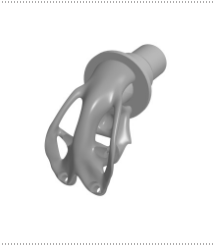APM FEM. Topological optimization
APM FEM. Topological optimization
Application for optimizing the distribution of material in the design area, taking into account loads and restraints. Consists of two parts: APM FEM. Topological optimization. Additional module and procedure for smoothing surfaces.
Topological optimization allows you to create a model with specified performance characteristics, reducing the material consumption of a part or an entire structure.
The following parameters of the model can serve as an optimality criterion:
- rigidity,
- strength,
- weight.
An important stage of optimization is the choice of the design area in which the material can be located. To obtain a better result, it is necessary to give a deliberately larger volume, taking into account design and technological limitations.
The sequence of actions corresponds to the usual static calculation in APM FEM. Loads, restraints are set, a finite element mesh is generated. The difference is in setting the parameters of the optimization problem.
The sequence of formation of the optimization problem:
- Response generation are selectable control variables of the calculated design. Available responses are:
- detail volume,
- total strain energy,
- weight,
- moving a node or its projection,
- displacement of two nodes,
- voltage of a group of elements.
- Selecting an objective function for one of the responses, minimizing or maximizing it.
- Set limits as a lower or upper bound on the response.
- Setting technological restrictions:
- maximum and minimum material thickness,
- part symmetry,
- stamping,
- extrusion,
- 3D printing.
- Statement of the optimization problem. The choice of one of the objective functions and restrictions for it.
The result of optimization is the distribution of volume fractions on the results map. Based on the distribution, it is possible to form an isosurface corresponding to a certain value of the volume fraction. This surface can then be smoothed and solidified using the Freehand tools.
Free form is the surface of a polyhedron rounded at vertices and edges. A free form is created according to a polygonal mesh, which can be modified, for example, as a result of “dragging” vertices, faces or edges, and other actions.
For the resulting solid body, it is necessary to once again calculate the strength to make sure that the object is working and that it meets the specified criteria.
Requires for work: KOMPAS-3D , APM FEM
